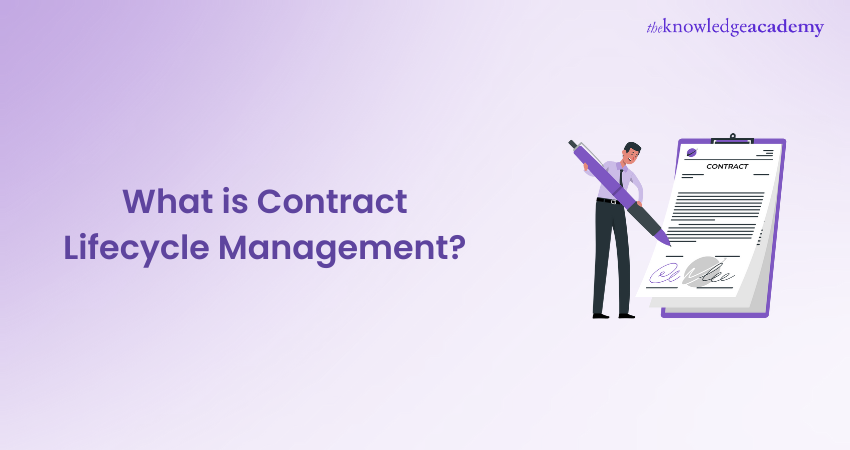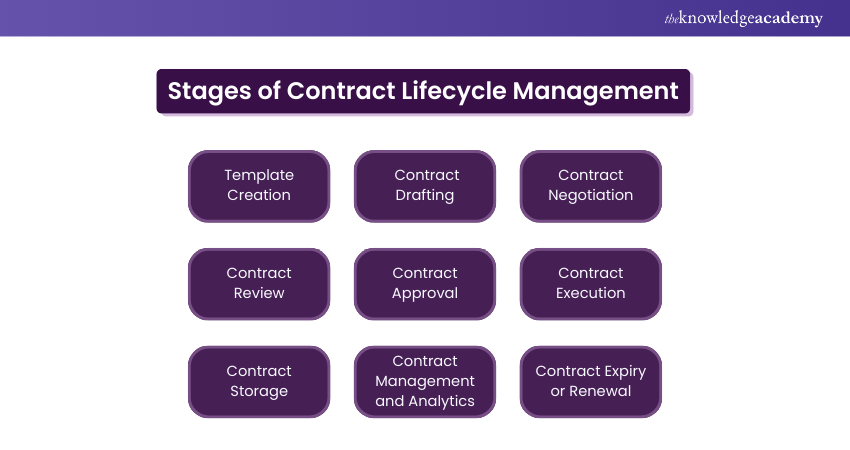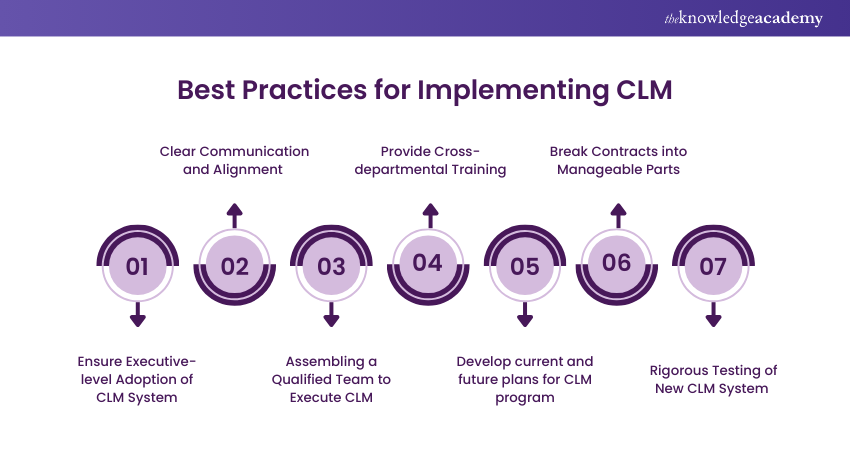We may not have the course you’re looking for. If you enquire or give us a call on +44 1344 203 999 and speak to our training experts, we may still be able to help with your training requirements.
We ensure quality, budget-alignment, and timely delivery by our expert instructors.

Have you ever wondered how businesses handle the complex process of creating, managing, and renewing agreements? That’s where Contract Lifecycle Management (CLM) comes in! CLM is more than just tracking contracts; it’s about ensuring smooth operations, reducing risks, and unlocking value at every stage of a contract’s journey. Whether you’re drafting, negotiating, or renewing contracts, CLM simplifies the process, saves time, and boosts compliance. In this blog, we’ll explore the stages, benefits, and tools that make CLM a game-changer for businesses. Let’s dive in!
Table of Contents
1) Understanding What is Contract Lifecycle Management?
2) What are the Stages of Contract Lifecycle Management (CLM)?
3) Best Practices for Implementing CLM
4) Key Metrics for Contract Lifecycle Management
5) What is Contract Lifecycle Management Software?
6) What are the Key Benefits of Contract Lifecycle Management Software?
7) The Future of Contract Lifecycle Management
8) Conclusion
Understanding What is Contract Lifecycle Management?
Contract Lifecycle Management (CLM) can be defined as managing and tracking every aspect of a contract for compliance, performance, and other success factors through each stage of its lifecycle. Contract Lifecycle Management encompasses the tracking and managing of a contract from execution to renewal or expiration.
The management process begins when a contract is requested and continues throughout the delivery and into contract renewal. A robust CLM process helps organizations adopt a disciplined approach to managing agreements, which helps mitigate risk and increases the likelihood that essential contracts perform as expected, as detailed in the Contract Management Career guide.
What are the Stages of Contract Lifecycle Management (CLM)?
Several stages make up the contract creation process, all of which we will discuss briefly as follows:

a) Template Creation
This is the first step in preparing standard contract templates. These templates include commonly used terms and conditions, making the process faster and more consistent. Templates ensure that contracts follow company guidelines and reduce the risk of errors. They also save time by providing a ready-made structure for different types of agreements.
b) Contract Drafting
At this stage, a new contract is created using the template or customised as needed. All key details, such as names, dates, and agreements, are added. Drafting ensures that the contract is tailored to the specific deal or relationship. It also acts as the foundation for further discussions and reviews.
c) Contract Negotiation
After the contract has been created, it needs to be negotiated with counterparties (i.e., companies with whom one signs contracts) before signing them. While a contract is being negotiated, legal teams on both parties need to be able to detect document changes, comments and versions.
d) Contract Review
The contract is carefully checked for accuracy, legal compliance, and alignment with company policies. This step ensures there are no mistakes or issues. A thorough review prevents legal disputes and financial risks. It also guarantees that the contract protects the interests of all parties.
e) Contract Approval
After the review is finalised, the contract is forwarded to the appropriate individuals for approval. The process moves to the next stage only after their consent is secured. Approval ensures that authorised personnel have thoroughly checked and validated the terms. It also confirms that the contract aligns with the organisation's goals and policies.
f) Contract Execution
Once all parties involved are ready to agree to the contract, they will have to sign it. This step of the process poses interesting logistical challenges for Contract Lifecycle Management because the prevalent tools for this step – the eSignature solutions – must be sold as separate solutions.
g) Contract Storage
The most basic requirement is that the contracts are stored securely. However, it is also important to make sure that the company folders are easy to navigate, that metadata is recorded in a central database for convenient reporting, and that the contextual history of a contract is stored and not just the executed contract. Contract storage is an excellent instance of a contracting task that might be handled appropriately by general software solutions in the early stages of a company.
h) Contract Management and Analytics
The contract is regularly tracked to ensure compliance with terms, deadlines, and obligations. Analytics help improve future contracts and processes. Monitoring ensures that all commitments are met and no key dates are missed. Analysis provides insights to optimise contract performance and reduce risks.
i) Contract Expiry or Renewal
When the contract ends, it is either closed or renewed based on the agreement. This step ensures nothing is missed and keeps relationships intact. Renewals are handled proactively to avoid disruptions. If a contract is closed, its outcomes and lessons are documented for future improvements.
Learn effective contract strategies with our Contract Management Training – Join today!
Best Practices for Implementing CLM
These primary steps will help you deploy the Contract Management System in the whole enterprise:

1) You need to begin at the executive level, ensuring that all executives embrace the Contract Management in Procurement system. Without your company's support, it will be challenging to allocate resources for the budget, and training will become difficult.
2) Clear Communication and proper alignment at the highest level will inspire the organisation to implement a Contract Management System.
3) You cannot properly implement CLM if you don’t have a strong team. To make your CLM effective, assemble a qualified team to help you govern and execute the program efficiently. However, remember, before you create a team, the organisation's leaders must be on board and aligned with your CLM program.
4) Training is crucial if you want to implement Contract Lifecycle Mangement successfully. The training needs to occur across several departments so employees can learn how to use the new technology according to their necessity and which will suit the department they are a part of.
5) It would help if you had a current plan and a future plan. If you don’t know what you want out of your CLM programs, you will never be able to achieve your goal. So, formulate a future and current plan, then link the gap between them. You can start this by assessing your present Contract Management System and then identifying the areas in which you need to improve.
6) If you set the metrics and goals of the new Contract Lifecycle Management program, you can demonstrate your Return on Investment (ROI) from the very early stages. If you clearly define your organisation's project success, it will not get overlooked in the implementation stage.
7) Break up the large chunks of the contract into small, manageable sizes. This will help you in tackling the implementation and yield a quick ROI. It will also give you the benefit of starting small. When starting small, you can introduce a Minimal Viable Product (MVP), allowing you to learn and leverage important insights down the process, a strategy often considered when comparing Contract Manager vs Project Manager responsibilities.
8) You need to prioritise contracts and migrate them into the new CLM platform as soon as possible. You will come across many legacy contracts and compliance documents while relocating them. This can concern a few organisations, especially those just starting their digital journey.
9) You need to rigorously test your new CLM to see if it generates the result initially planned for your organisation. Involving talented and knowledgeable people in your organisation in the Contract Management testing process will help avoid or reduce project risks during roll-out.
Master the art of negotiating a formal business agreement through our Commercial Contracts Management Training - Sign up now!
Key Metrics for Contract Lifecycle Management
Here are the key metrics:
Contract Cycle Time
This measures how long it takes to complete a contract from start to finish. A shorter cycle time means contracts are handled efficiently. Delays in approvals or negotiations can make the process longer. Reducing cycle time helps save time and improves overall business productivity. When comparing Cycle Time vs Lead Time, it's important to recognise that cycle time focuses specifically on the time spent actively working on a contract, while lead time includes the entire process from the initial request to the final contract execution, including any waiting periods or delays.
Contract Renewal Rate
This shows the percentage of contracts that are successfully renewed when they expire. A high renewal rate indicates good relationships and satisfaction between parties. It also helps businesses maintain steady revenue and avoid disruptions. Tracking this metric helps identify areas to improve retention efforts.
Contract Value
This represents the total financial worth of a contract. It includes payments, services, or goods agreed upon by the parties. Monitoring contract value helps businesses understand their financial impact. It also helps prioritise high-value contracts for more attention and resources.
Contract Compliance Rate
This measures how often contracts meet agreed-upon terms and conditions. A high compliance rate shows that parties are following through on their commitments. Non-compliance can lead to risks, disputes, or financial losses. Improving this metric builds trust and ensures smoother operations.
Contract Dispute Resolution Time
This tracks how long it takes to resolve conflicts or disagreements related to a contract. Faster resolution times mean issues are addressed quickly, reducing delays. Prolonged disputes can damage relationships and slow down business. Focusing on this metric helps improve communication and problem-solving processes.
Contract Termination Rate
This shows the percentage of contracts that are cancelled before they are completed. A high termination rate may signal issues like poor performance or misaligned expectations. Analysing this metric helps identify root causes and improve future contracts. Keeping this rate low ensures better outcomes and stronger partnerships.
What is Contract Lifecycle Management Software?
Contract Lifecycle Management Software can be defined as technology enabling organisations to simplify and automate their contract workflow, from creation to tracking and reporting. CLM software offers valuable features during each stage of the contract lifecycle. This differentiates it from other solutions, such as contract negotiation or contract reminder software, which focus on one phase of the lifecycle.
What are the Benefits of Contract Lifecycle Management Software?
Contract Lifecycle Management software simplifies managing the different processes involved in the contract lifecycle. Almost every aspect of the CLM process can be accomplished manually, but incorporating purpose-built software helps save you valuable time, reduce risks and provide an organisation with greater insight into the details of a contract portfolio. Let’s discuss some of its benefits:
1) Faster, Easier Contract Signing: CLM software solutions have a built-in electronic signature capability or can be integrated with standalone e-sign tools. This feature saves you the hassle of securing a physical signature and helps you avoid delays once all parties are ready to proceed with an agreement.
2) Contract Organisation, Access and Visibility: CLM software helps an organisation store and organise all its contracts in one central, online location. This feature of CLM software facilitates convenient searching for an organisation’s essential documents. Advanced search functionality makes finding contracts or key terms easier and eliminates the need to scour through inboxes and shared drives to find contracts.
3) Automated Contract Tracking and Reporting: CLM software reduces manual work by automating contract tracking. It sends email reminders for important dates, like contract expiry or termination deadlines, using alerts and notifications. Custom reporting tools allow organisations to create, schedule, and share reports easily. Users can quickly see details such as upcoming expirations or specific clauses like force majeure.
Learn about contract negotiations in depth by signing up for our Contract Negotiation Training - join today!
The Future of Contract Lifecycle Management
The future of Contract Lifecycle Management (CLM) will depend heavily on advanced technologies like Artificial Intelligence (AI) and automation. AI simplifies tasks such as contract drafting, review, and compliance checks, enhancing efficiency and minimising errors. Automation will make it easier to track deadlines, send reminders, and generate reports without manual effort.
CLM systems will also become more user-friendly and accessible. Cloud-based platforms will allow teams to collaborate in real-time from anywhere. Insights from data analytics will help organisations make smarter decisions, optimise contracts, and improve business outcomes. This evolution will make CLM faster, more efficient, and more valuable for businesses.
Conclusion
We hope you have gained valuable insights into Contract Lifecycle Management (CLM) and how it can transform the way organisations manage contracts. From understanding its stages to exploring its benefits and future potential, CLM proves to be an essential tool for enhancing efficiency, reducing risks, and driving business success. By adopting CLM practices and software, businesses can streamline processes, ensure compliance, and build stronger relationships.
Learn about contract creation with this Contract Management Certification – Join today!
Frequently Asked Questions
What is the Contract Lifecycle Management Process?

Contract Lifecycle Management is the process which automates and streamlines contract processes during its important stages. These primary stages include initiation, authoring, process, workflow, negotiation, execution, approval, ongoing compliance and contract renewal.
What is the Difference Between Contract Management and Contract Lifecycle Management?

Contract Management is about overseeing individual contracts, focusing on performance and compliance. Whereas, Contract Lifecycle Management is about the entire process of a contract's life, from initiation, drafting, negotiation, execution, to renewal or termination.
What are the Other Resources and Offers Provided by The Knowledge Academy?

The Knowledge Academy takes global learning to new heights, offering over 3,000 online courses across 490+ locations in 190+ countries. This expansive reach ensures accessibility and convenience for learners worldwide.
Alongside our diverse Online Course Catalogue, encompassing 19 major categories, we go the extra mile by providing a plethora of free educational Online Resources like News updates, Blogs, videos, webinars, and interview questions. Tailoring learning experiences further, professionals can maximise value with customisable Course Bundles of TKA.
What is The Knowledge Pass, and How Does it Work?

The Knowledge Academy’s Knowledge Pass, a prepaid voucher, adds another layer of flexibility, allowing course bookings over a 12-month period. Join us on a journey where education knows no bounds.
What are Related Courses and Blogs Provided by The Knowledge Academy?

The Knowledge Academy offers various Contract Management Courses, including Contract Management Certification Training, Contract Negotiation Training, and Intellectual Property Training. These courses cater to different skill levels, providing comprehensive insights into Contract Management Strategies.
Our ISO & Compliance Blogs cover a range of topics related to Contract Management, offering valuable resources, best practices, and industry insights. Whether you are a beginner or looking to advance your Contract Management skills, The Knowledge Academy's diverse courses and informative blogs have you covered.
Upcoming Health & Safety Resources Batches & Dates
Date
 Contract Management Certification Training
Contract Management Certification Training
Thu 22nd May 2025
Thu 17th Jul 2025
Thu 18th Sep 2025
Thu 20th Nov 2025






 Top Rated Course
Top Rated Course



 If you wish to make any changes to your course, please
If you wish to make any changes to your course, please


